Friday afternoon, time to clean up my desk. What happened this week?
First of all, as a follow-up on the latest video showing possible cheating by the Polish pair Balicki and Zmudzinski, both the PBU (Polish Bridge Union) and the EBL decided to investigate the matter. The PBU by starting from scratch, the EBL as a follow-up to their earlier investigations. The PBU also decided to suspend BZ pending the investigation. While I still have my doubts about the legal basis of all this, investigating what is going on here is a good thing in my opinion. Definitely to be continued.
In the US, the Spring Nationals are underway. Gone are the days where I played them myself (wife, kids and dogs to blame) but thanks to BBO and the ACBL site, I can stil follow the action from here.
The various Dutch players didn’t do so well, of the 20 Dutch participants, only 9 survived the first day of the Vanderbilt, the major team event there. 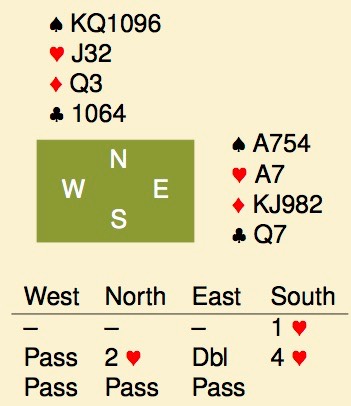 Now, on Friday, only one of them is still playing; Jan Jansma in the international team Rosenthal. Logging in to Bridgebase early this morning, I find Jan declarer on this board with a few boards to go and a little behind. Try the hand as a problem.
Now, on Friday, only one of them is still playing; Jan Jansma in the international team Rosenthal. Logging in to Bridgebase early this morning, I find Jan declarer on this board with a few boards to go and a little behind. Try the hand as a problem.
Partner leads the ♠3 (3rd/5th), for the ♠Q, ♠A and ruffed by declarer. Declarer continues with the ♦4, ♦6, ♦Q to your ♦K. Now what. Upside-down count, if you think that is relevant. Solution below.
The Vanderbilt will conclude tomorrow, and with the wife out of town for the weekend, you know that I’m doing on Saturday night.
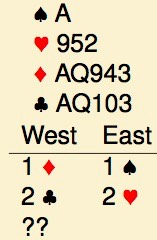
Back home, I ran across this bidding problem:
The first 2 bids are easy but now what?
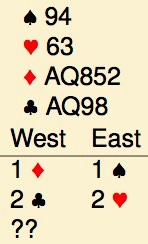
And while you are thinking about this, consider this hand from bridgewinners.com a couple of weeks ago. Same auction, different hand, diferent problem, but your turn again.
A bit of theory for the Friday afternoon.
4th suit forcing is one of those conventions that is taught to new players and that everybody has been playing ever since. The convention is described in many elementary textbooks and the list of responses to a 4th suit bids is usually something like:
- 3 card support for partners suit: support partner
- 4 cards in the 4th suit: raise the 4th suit
- Extra length in one of your suits: rebid the first suit to show 6-4, rebid the second suit to show 5-5
- Stopper in NT: rebid in NT.
Notice anything odd in this list? No? Well, what about the case where you do not have any of those features? In this case, one really needs a 5th option:
- None of the above: bid ...
What that is we’ll discuss in a moment, but the first thing to notice is that none of the basic textbooks that I consulted actually considered this option. Strange, don’t you think? It is like discussing blackwood without discussing what to do with 0 aces.
Yet, there is a simple but effective way to solve this: After a 4th suit forcing bid, the cheapest bid not in NT, is an artificial negative and denies any of the other options. With this agreement, the second problem becomes easy:
1♦-1♠; 2♣-2♥
- 2♠: The negative bid, denying all other options
- 2NT: ♥-stopper for NT
- 3♣: 5♦-5♣
- 3♦: 6♦-4♣
- 3♥: 4♥, so presumably 1444 or 0454.
- 3♠: 3♠, most likely 3♠-1♥-5♦-4♣
Similar sequences are left as an exercise to the reader.
The first hand brings up another issue that is frequently undiscussed: if partner uses 4th suit forcing, is he allowed to pass the response? The modern tendency seems to be no, which effectively means that the 4th suit bid becomes a game force. The advantage of this approach is that both sides can describe their hands at the 3 level and there never is a need to jump in order to keep things forcing. This also allows you to temporize on those hands where you have no idea in which suit to play yet. It also allows you to deal with the first hand: After 1♦-1♠; 2♣-2♥ simply rebid 2♠, and wait for partner to disclose why he bid 2♥. No need to jump around.
The finaly thing: what about a jump in the 4th suit (1♦-1♠; 2♣-3♥) and how does this compare to the auction (1♦-1♠; 2♣-2♥; (2♠…3♦)-3♥). Again, this is not discused in most elementary books but expert consensus is that the first auction shows a 5-5 or better, with strong suits, while the second does not promise hearts, but simply expresses doubt about the final denomination. It typically asks for a little help in the 4th suit, such as ♥Jxx or ♥Qx.
So much for the theory, is this the only or the best answer? No and no, what is important that you discuss a number of things with partner:
- What do we bid over the 4th suit with “none of the above”, or nothing to show at this point?
- Does a 4th suit bid promise a rebid?
- What about a jump in the 4th suit, or repeated bid in the 4th suit?
No matter what you agree, you will be better off than a pair that hasn’t done this.
Solutions: First the defensive problem.
Declarer definitely made it hard for you by putting you on lead at the first opportunity, and you have to guess what is going on.
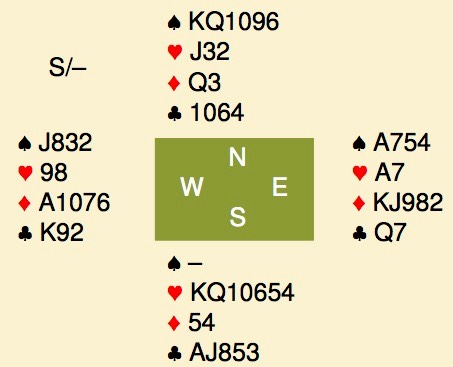
At a first glance it looks that he is trying to develop some diamond tricks, with ♦Axxx, either the ♦Q wins or he is in a position to ruff a diamond or two. We already know that he has a spade void, so his hand could be something like ♠--/♥KQxxxx/♦Axxx/♣Axx. With this hand, declarer has 10 tricks: ♠K, 5 hearts in hand plus 2 diamond ruffs in the dummy, and 2 aces.
Can we stop him from taking those tricks? Yes, play the ♥A and a heart, and he only scores one diamond ruff and has to find his 10th trick elsewhere. Of course, if declarer has another winner somewhere, he will still make but then the hand was cold anyway.
So, it seems reasonable to play the ♥A and a heart to cut down ruffs.
Not so, the full deal was this. Declarer won the second trump in the dummy, pitched a diamond on the ♠K and gave up a club for 10 tricks and a 9 imp gain. This was board 59, after 58 boards Jan was down 14. 9 imps on this board and 6 imp partscore gain on the last board added up to 15 and a win by 1. That is enough in a knock-out event.
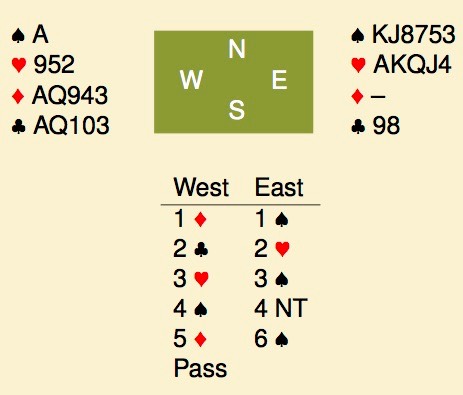
The bidding problems: I cannot find the second hand, but I do remember responder had a 15 count with 5♠ and double heart stop. 1♦-1♠; 2♣-2♥; 2♠ to deny anything useful was sufficient to end up in the right contract. On the other hand, our opponents bid like this, ending up 6♠ that requires trumps to break 3-3. 6♥ is obviously a lot better as you can ruff a spade to overcome a 4-2 ♠-split with somebody holding ♠Q10xx. In fact, it isn’t the worst 7♥ that I have seen. After 1♦-1♠; 2♣-3♥; 4♥ you should not have a problem getting to a ♥-contract.
It is now almost 4pm, time for the Friday afternoon drinks. Earlier in the week, I received a box of Rheinhessen Rotling. Time to open one and see if it tastes as good as they promised me.
